Answered step by step
Verified Expert Solution
Question
1 Approved Answer
please show all work 2HgCl2(ag)+C2O42(ag)2Cr(ag)+2CO2(g)+Hg2Cl2(s) Determine the rate law and calculate the value of theeate constant, K ? 2. The first-order reaction, 2N2O(g)2N2(g)+O2(g), has a
please show all work 
2HgCl2(ag)+C2O42(ag)2Cr(ag)+2CO2(g)+Hg2Cl2(s) Determine the rate law and calculate the value of theeate constant, K ? 2. The first-order reaction, 2N2O(g)2N2(g)+O2(g), has a rate constant equal to 0.76s1 at 1000K. How long (in sec) will it take for the concentration of N2O to decrease to 42% of its intitial concentration? [3 pts 3. The aquation of tria(1,10-phenanthroline)iron(II) In acid solution takes place according to the equation: Fe(phen)32++3H3O++3H2OFe(H2O62++3phenH+ If the activation energy, Ea, is 126kJ/mol and the rate constant at 30Cls9.8103min1, what is the rate constant at 50C ? Be sure to indicate the correct unit with your answer. [3 pts] 4. In aqueous solution, hypobromite ion, BrO;, reacts to produce bromate ion, BrO3, and bromide lon, Br. according to the following chemical equation. 3BrO(aq)BrO3(aq)+2Br(aq) A plot of 1[BrB1] vs. time is linear and the slope is equal to 0.056M1s1, If the initial concentration of Bro- is 1.0 M, how long (in seconds) will it take one-half of the Bro- lon to react? [ 3 pts] 
Step by Step Solution
There are 3 Steps involved in it
Step: 1

Get Instant Access to Expert-Tailored Solutions
See step-by-step solutions with expert insights and AI powered tools for academic success
Step: 2

Step: 3

Ace Your Homework with AI
Get the answers you need in no time with our AI-driven, step-by-step assistance
Get Started


